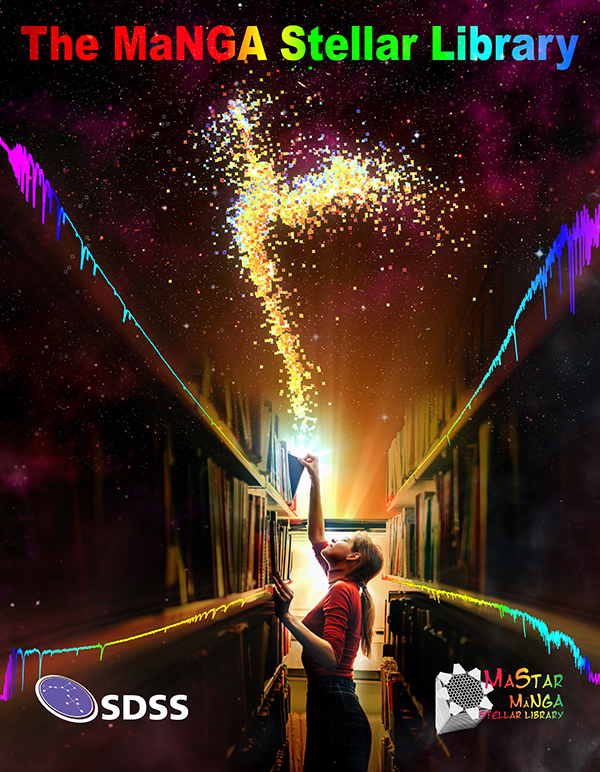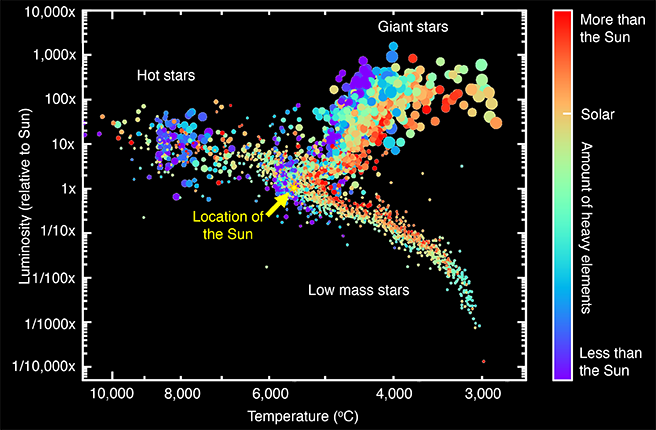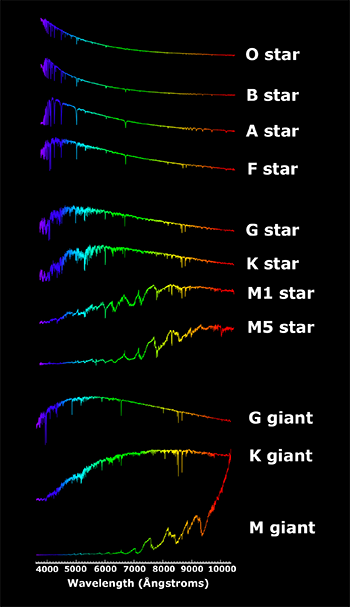In this imaginative visualization of MaStar, a user of the Stellar Library selects a spectrum corresponding to a certain type of star.
Of course, in reality there is no physical library location; the stellar spectra are stored digitally and available to anyone at www.sdss.org.
Image Credit: Dana Berry/SkyWorks Digital Inc.; SDSS collaboration
Want to learn everything there is to know about a subject? Go to the library.
Want to learn everything there is to know about stars? Go to the stellar library.
Today, astronomers from the Sloan Digital Sky Survey (SDSS) announced the opening of a new “stellar library” containing spectra of thousands of stars in our Milky Way galaxy. Having access to this library will help astronomers understand not only our own Galaxy, but galaxies across the Universe.
The announcement came at the annual meeting of the American Astronomical Society (AAS) in Seattle, WA. The new library is known as the “MaNGA Stellar Library,” named after the SDSS’s Mapping Nearby Galaxies at Apache Point Observatory (MaNGA) survey, which it was designed to support. MaNGA’s goal is to understand the detailed internal structure of galaxies – but of course galaxies are made of stars, so understanding a galaxy requires understanding the stars that compose it. For decades, astronomers have been trying to figure out what unique mix of stars best explains the light that we see from every distant galaxy.
“It’s a bit like hearing a symphony,” says Renbin Yan of the University of Kentucky, the Principal Investigator of the MaNGA Stellar Library project. “We hear the sound from the entire orchestra at once, but we can only understand the music if we know which instruments are playing.”
For galaxies, the “music” is the light coming from the mix of stars that make up a galaxy, along with its detailed history of star formation. The problem is that other galaxies are so far away that astronomers cannot distinguish individual stars in them. The solution is to study thousands of stars in our own Milky Way. Once they identify all of the possible “instruments” using stars in the Milky Way, they can decipher the “music” of distant galaxies.
Renbin Yan
“It’s a bit like hearing a symphony. We hear the sound from the entire orchestra at once, but we can only understand the music if we know which instruments are playing.”
In a symphony, the sound of each instrument has its own unique tone; in the case of galaxies, the light of each type of star has its own unique spectrum. A spectrum measures how much light a star gives off at different wavelengths, a pattern unique to each type of star. Like sheet music shows how a song will sound, “reading” a spectrum gives important information about a star, like its temperature, size, and chemical composition. By observing thousands of stars of all types, astronomers can build up a “library” of stellar spectra. Thus, when they measure the spectrum of a distant galaxy, they can try to build the spectrum by putting together different combinations of stars from the stellar library until they find a combination that fits.
Arguably the most iconic diagram in astronomy, the “Hertzsprung-Russell” diagram shows the temperature and brightness (luminosity) of stars of different types.
This version shows all of the stars currently in the MaNGA Stellar Library, with information on their chemical makeup provided by the MaStar spectra.
Each circle represents a star whose spectrum is in the stellar library. The horizontal axis shows each star’s surface temperature, while the vertical axis shows the star’s luminosity relative to our Sun. The size of each circle shows the star’s surface gravity, a measure of its size – allowing us to distinguish between dwarf and giant stars. The colors of the circles indicate the amount of heavy elements (that is, heavier than hydrogen and helium) relative to the Sun.
Image Credit: SDSS collaboration
“To reconstruct the spectrum of a galaxy, you need to get good spectra for the widest range of stars you possibly can,” says Karen Masters, Spokesperson for the Sloan Digital Sky Survey project, “This allows you to estimate the mass the galaxy has in stars, and reconstruct its star formation history, both crucial to complete the goals of the MaNGA survey part of SDSS-IV. As astronomers often say, this is just like reconstructing a piano from the sound it makes falling down the stairs.”
Those accurate spectra come from the MaNGA spectrograph. The MaNGA survey spends most of its time observing galaxies, but over the last three years, it has also measured spectra for more than 3,000 stars of all colors and sizes. These spectra have been collected into the MaNGA Stellar Library, or MaStar for short.
The MaNGA stellar library began out of necessity. At the beginning of the fourth phase of the SDSS in 2013, the MaNGA team realized that there was no suitable library of stellar spectra covering the wavelength range that MaNGA would use. Rather than be stymied by the lack of such a library, the team realized they had an opportunity to create just such a library by working with the other survey programs that make up the SDSS.
Each colored curve in this image shows the spectrum for one star in the MaNGA Stellar Library. The curves show the wavelengths of light, covering the entire visible spectrum and beyond, from ultraviolet to infrared (from left to right). The height of each the curve at each point shows the intensity of light at that wavelength. The peaks and valleys of each curve indicate the presence of different chemical elements.
The top eight curves are for typical stars, labeled with their spectral type and sorted in order of temperature – the O star (top) is the hottest, while the M5 star (eighth from top) is the coolest (the Sun is a G star). The bottom three spectra are for giant stars, again sorted from hottest to coolest.
Image Credit: Renbin Yan (University of Kentucky) and the SDSS collaboration
“What makes the MaStar project possible is the parallel observing capability in SDSS,” Yan says. “At the same time as our colleagues use the infrared spectroscope to observe stars in our Galaxy, we can use the MaNGA instrument to simultaneously observe other stars in optical. This is enabled by the way SDSS uses fibers to observe the light from many stars at once. We basically get the observations for free.” Thus, with this strategy of “piggybacking” on other SDSS observations, researchers from the MaNGA team were able to get the right spectra for the right stars to create the stellar library they so desperately needed. All the spectra for all these stars have been released as part of the SDSS’s Data Release 15, and are available online through the project’s website at www.sdss.org.
Once astronomers have a library that includes spectra for as many types of stars as possible, they can figure out how many of each type of star add up to make the galaxy spectrum, and thus understand the galaxy’s history of star formation. In Yan’s analogy, they can understand which instruments are making the music. The key is to include as many types of stars as possible in the library.
Claudia Maraston of University of Portsmouth is building models of galaxy spectra using this library, and she says, “The comprehensive coverage of the MaStar library will allow us to make the most accurate models of galaxies to date.”
“MaStar is the most inclusive stellar library ever created,” Yan says. “That inclusivity is our biggest strength: the more instruments we can recognize, the better we can understand the symphony.”
And the MaNGA Stellar Library will just keep growing. With observations continuing at Apache Point Observatory until at least 2020, it will become the biggest and most inclusive stellar library ever made.
Images
In this imaginative visualization of MaStar, a user of the Stellar Library selects a spectrum corresponding to a certain type of star.
Of course, in reality there is no physical library location; the stellar spectra are stored digitally and available to anyone at www.sdss.org.
Image Credit: Dana Berry/SkyWorks Digital Inc.; SDSS collaboration
Each colored curve in this image shows the spectrum for one star in the MaNGA Stellar Library. The curves show the wavelengths of light, covering the entire visible spectrum and beyond, from ultraviolet to infrared (from left to right). The height of each the curve at each point shows the intensity of light at that wavelength. The peaks and valleys of each curve indicate the presence of different chemical elements.
The top eight curves are for typical stars, labeled with their spectral type and sorted in order of temperature – the O star (top) is the hottest, while the M5 star (eighth from top) is the coolest (the Sun is a G star). The bottom three spectra are for giant stars, again sorted from hottest to coolest.
Image Credit: Renbin Yan (University of Kentucky) and the SDSS collaboration
Arguably the most iconic diagram in astronomy, the “Hertzsprung-Russell” diagram shows the temperature and brightness (luminosity) of stars of different types.
This version shows all of the stars currently in the MaNGA Stellar Library, with information on their chemical makeup provided by the MaStar spectra.
Each circle represents a star whose spectrum is in the stellar library. The horizontal axis shows each star’s surface temperature, while the vertical axis shows the star’s luminosity relative to our Sun. The size of each circle shows the star’s surface gravity, a measure of its size – allowing us to distinguish between dwarf and giant stars. The colors of the circles indicate the amount of heavy elements (that is, heavier than hydrogen and helium) relative to the Sun.
Image Credit: SDSS collaboration
Contacts
- Renbin Yan, Principal Investigator of MaNGA Stellar Library (MaStar), University of Kentucky
rya225@g.uky.edu, +1-859-257-0795 - Claudia Maraston, University of Portsmouth
claudia.maraston@port.ac.uk, +44-23-9284-5139 - Karen Masters, SDSS Scientific Spokesperson, Haverford College
klmasters@haverford.edu, +1-610-795-6066
Twitter: @KarenLMasters / @SDSSurveys - Karen Masters, SDSS Public Information Officer, Johns Hopkins University
raddick@jhu.edu, +1-410-516-8889
Twitter: @raddick
About the Sloan Digital Sky Survey
Funding for the Sloan Digital Sky Survey IV has been provided by the Alfred P. Sloan Foundation, the U.S. Department of Energy Office of Science, and the Participating Institutions. SDSS acknowledges support and resources from the Center for High-Performance Computing at the University of Utah. The SDSS web site is www.sdss.org.
SDSS is managed by the Astrophysical Research Consortium for the Participating Institutions of the SDSS Collaboration including the Brazilian Participation Group, the Carnegie Institution for Science, Carnegie Mellon University, the Chilean Participation Group, the French Participation Group, Harvard-Smithsonian Center for Astrophysics, Instituto de Astrofísica de Canarias, The Johns Hopkins University, Kavli Institute for the Physics and Mathematics of the Universe (IPMU) / University of Tokyo, the Korean Participation Group, Lawrence Berkeley National Laboratory, Leibniz Institut für Astrophysik Potsdam (AIP), Max-Planck-Institut für Astronomie (MPIA Heidelberg), Max-Planck-Institut für Astrophysik (MPA Garching), Max-Planck-Institut für Extraterrestrische Physik (MPE), National Astronomical Observatories of China, New Mexico State University, New York University, University of Notre Dame, Observatório Nacional / MCTI, The Ohio State University, Pennsylvania State University, Shanghai Astronomical Observatory, United Kingdom Participation Group, Universidad Nacional Autónoma de México, University of Arizona, University of Colorado Boulder, University of Oxford, University of Portsmouth, University of Utah, University of Virginia, University of Washington, University of Wisconsin, Vanderbilt University, and Yale University.






